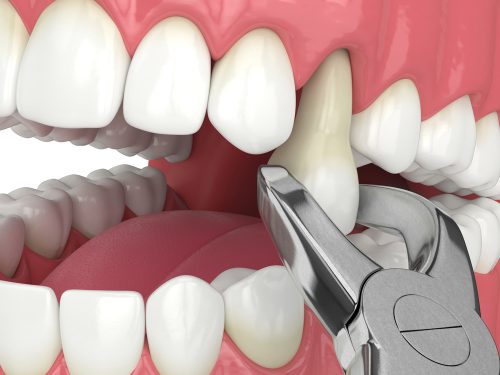Tooth Extractions in Houston, TX
Preserve Your Smile, Get Rid of Problem Teeth!
Sometimes a tooth causes more problems than it solves, and for the sake of your smile, it may be time to let it go. Tooth extraction services are highly common, with millions of people worldwide getting extractions for numerous reasons.
The Houston, TX, general dentists of Dentistry of Highland Village explain the intricacies of tooth extraction. To gain a more comprehensive understanding of tooth extractions and their implications on oral health, call our Houston dental practice at (713) 360-7700 or read the helpful guide below.
What is Tooth Extraction?
Tooth extraction, sometimes
The decision to undergo a tooth extraction involves a careful assessment of the patient’s oral health and dental treatment needs. In some cases, extractions are recommended to prevent further damage or complications, such as removing wisdom teeth or addressing gum disease.
Reasons for Tooth Extraction Services
There are several reasons why tooth removal may be necessary. These include:
- Impacted Wisdom Teeth: Impacted wisdom teeth are those that haven’t erupted properly and are stuck under the gum or lack sufficient space to break through the gum.
- Dental Complications: Extracting wisdom teeth can alleviate painful symptoms and prevent potential damage to neighboring teeth and tissues.
- Gum Disease: Gum disease, an infection of the tissues and bones that support the teeth, can lead to tooth loss, discomfort, and infection. In severe cases, tooth extraction may be necessary to address the issue and protect the patient’s oral health.
- Overcrowded Teeth: Overcrowded teeth occur when there is insufficient space in the jaw for all the teeth to align correctly, leading to crooked, overlapping, or twisted teeth. Removing teeth can create space for proper alignment and rectify bite issues, ultimately improving oral health and overall well-being.
- Damaged or Decayed Teeth: Damaged or decayed teeth are impacted by tooth decay, permanent damage to the tooth’s hard surface that results in cavities. If left untreated, tooth decay can cause further damage to the teeth and gums, requiring more extensive dental treatments or tooth extraction.
- Tooth Infection: A tooth infection, also known as a dental abscess, is an accumulation of pus resulting from a bacterial infection in the tooth or gums. Treatment for tooth infection usually involves antibiotics and a root canal procedure, but in some cases, tooth extraction may be necessary.
- Preparation for Dentures: If a patient needs dentures, extraction may be necessary to remove any remaining natural teeth that could interfere with the fit and comfort of the dentures.
- Trauma: A tooth may need extraction following damage from a traumatic injury.
What are Wisdom Teeth?
Wisdom teeth, also known as third molars, are the last set of adult teeth to grow in, typically between the ages of 17 and 25. They are located at the back of the mouth, but not everyone develops all of their wisdom teeth. In many cases, wisdom teeth can become impacted, leading to severe pain, and other complications that may require extraction.
Types of Tooth Extractions
Tooth extractions can be broadly categorized into two types: simple extractions and surgical tooth extractions. Simple extractions involve the removal of a visible tooth situated above the gums and require minimal extraction preparation, while surgical tooth extractions are more complex procedures that involve the removal of gum tissue, bone, or both.
Simple Tooth Extraction
A simple extraction is a non-surgical procedure conducted on a visible tooth situated above the gums, requiring minimal preparation. Also called a non-surgical tooth extraction, during a simple extraction, your dentist uses a dental instrument to loosen the tooth and then remove it. Simple extractions are employed when a tooth is easily accessible and can be removed in one piece.
Surgical Extraction
A surgical tooth extraction, on the other hand, is a more complex dental procedure that involves the removal of a tooth that is not easily accessible. Also known as complex extraction, this process may require the removal of gum tissue, bone, or both, and may require stitches to close the site for proper healing. Generally, surgical extractions are performed on impacted wisdom or extensively damaged teeth.
Benefits of Tooth Extraction
There are several benefits of extracting teeth by your dentist’s recommendation, including:
- Improved Oral Health
- Pain Relief
- Making Room For Dental Restorations at the Extraction Site
- Preservation of Remaining Healthy Teeth
- Better Overall Health
The Tooth Extraction Procedure
Consultation
Before your tooth extraction, you’ll have a consultation with one of our Houston extraction dentists, Dr. Shah, Milman, or Dave. During the consultation, your dentist will review your medical history, discuss the rationale for the dental extraction, and address any potential risks or complications. Inform the dentist of any medications, vitamins, or supplements you are currently taking.
Preparation
Before the tooth extraction procedure, your dentist will numb the tooth and the surrounding area with a local anesthetic. This ensures your comfort during the extraction process. Depending on the complexity of the extraction, the dentist may also take dental X-rays to evaluate bone levels and ascertain the extent of damage.
Non-Surgical Tooth Extraction
For non-surgical tooth extraction, one of our dental professionals will employ specialized forceps, an instrument called a lifter, to grasp and gently rock the tooth back and forth, dislodging it from the tooth socket.
Surgical Tooth Extraction
The surgical tooth extraction process begins with an incision in the gum tissue to access the tooth. In cases where the tooth is impacted or extensively decayed, it may be divided into smaller fragments for easier extraction. Afterward, your dentist sutures the incision to aid in the healing process.
Post-Extraction Care and Recovery
Controlling Pain
- Taking Medication: Follow your dentist’s prescribed pain medication regimen to manage discomfort effectively.
- Rinsing with Warm Saltwater: Gently rinsing your mouth with a warm saltwater solution can alleviate dental pain and promote healing. Be sure to rinse gently, or you risk preventing clot formation at the dental extraction site.
- Applying Ice Packs: Apply an ice pack to the affected area in 15-minute intervals several times a day to reduce inflammation and numb the dental pain.
- Using Over-the-counter Pain Relievers: Over-the-counter pain relievers, when used as directed, can be a helpful complement to prescribed medications.
- Gauze Placement: Bite firmly on the gauze for the prescribed amount of time. Keeping the gauze in place as advised by your dentist helps control bleeding, aids in the formation of a blood clot, and provides relief.
- Additional Instructions: Always adhere to any specific aftercare instructions provided by your dentist. The initial numbness from local anesthesia should wear off within a few hours.
Reducing Swelling
- Ice Pack Application: Continue applying ice packs to the extraction site for short durations, several times a day, to minimize swelling. Note that it’s essential to avoid overusing ice packs, as this can lead to skin irritation or frostbite.
- Pain Medications: Over-the-counter pain medications, as directed, can help manage discomfort and reduce swelling.
- Head Elevation: Elevate your head while sleeping, preferably with an extra pillow, to further diminish swelling.
Oral Hygiene
- Brushing: Brush your teeth gently twice daily with fluoride toothpaste, being cautious around the extraction site. Brushing too hard can interfere with clot formation.
- Flossing: Continue daily flossing but be gentle around the extraction area to avoid dislodging the blood clot.
- Mouthwash: Use a dentist-recommended mouthwash to help maintain oral cleanliness. Rinse gently when using mouthwash to ensure the blood clot continues to form.
- Regular Dental Check-Ups: Schedule and attend regular dental check-ups and cleanings to ensure your overall oral health remains optimal.
Food and Diet Recommendations
- Eat Soft Foods: During the initial recovery period, focus on soft, nutritious foods that are easy to chew and swallow, such as yogurt, applesauce, mashed potatoes, oatmeal, and soups.
- Room-Temperature & Cold Foods: Avoid hot food as it may irritate the extraction site or encourage bleeding.
- Gradual Transition: As you become more comfortable, slowly reintroduce solid foods into your diet, transitioning from soft options.
- Hydration: Ensure you maintain adequate hydration by consuming enough fluids during your recovery period. Staying hydrated is vital for the healing process.
- Avoid Straws: Sucking on straws creates suction, which can dislodge the blood clot and interfere with the healing process.
Risks and Complications of Tooth Extraction
While tooth extractions are generally safe and routine procedures, there are potential risks and complications to keep in mind. These may include:
- Bleeding
- Infection
- Nerve damage
- Dry socket (a painful condition that can occur when the blood clot in the socket is dislodged)
- Damage to surrounding teeth or tissues
- Reactions to anesthetic
Discuss any concerns with our Houston dentist before the procedure, and carefully follow aftercare instructions to help minimize your risk of complications after getting a tooth pulled.
Tooth Extraction Cost
On average, the cost of tooth extraction can range from $120 to $250 for a basic extraction. However, for those getting their wisdom teeth extracted, costs can range between $1,000 to $3,000 per tooth. Your total estimated cost will vary depending on factors such as:
- Type of extraction
- Where you’re located
- Dental insurance plan
- Additional procedures
- The experience of your dentist or oral surgeon
- Number of teeth being extracted
Frequently Asked Questions
The tooth extraction process is usually not painful, as local anesthetic numbs the area. However, patients may experience discomfort or pain after the procedure, which is easily manageable with pain medication prescribed by your dentist or oral surgeon.
The recovery time can vary depending on the individual and the complexity of the extraction. Most people can return to normal activities within a few days to a week after the procedure, but it may take several weeks
Dentists generally recommend sticking to soft, cool foods for the first few days after the procedure and avoiding hard, crunchy, or sticky foods that could irritate the extraction site. Be sure to follow any specific aftercare instructions from your dentist or oral surgeon.
Many dental professionals will suggest replacing missing teeth to prevent problems with chewing, speaking, and the alignment of surrounding teeth. Your dentist or oral surgeon can discuss replacement options with you, such as dental implants, bridges, or dentures.
Call Dentistry of Highland Village for Painless Extraction Services!
If you need a tooth extraction, consider Dentistry of Highland Village for painless extraction services. Our dentists are dedicated to providing a comfortable experience, utilizing the latest technology and techniques to ensure swift and comfortable extractions.
Call Dentistry of Highland Village by dialing (713) 360-7700 to schedule your appointment and take the first step towards a healthier smile. We’re here to help patients from Houston and surrounding areas such as Pasadena, Sugar Land, and Pearland, TX.
MOST INSURANCES WELCOME AND MAXIMIZED!
NEW PATIENT SPECIALS & FINANCING OPTIONS AVAILABLE.
Contact us and schedule your visit today.
The Proof is in Our Patients




Specials & Offers
Ask About Our Specials
$159
Exam, x-rays, and regular cleaning
$59
Emergency exam and x-ray
| Monday | 7:00 AM – 5:00 PM |
| Tuesday | 7:00 AM – 5:00 PM |
| Wednesday | 7:00 AM – 5:00 PM |
| Thursday | 9:00 AM – 7:00 PM |
| Friday | 7:00 AM – 5:00 PM |
| Saturday | 7:00 AM – 3:00 PM |
| Sunday | Closed |







